English Literature > AS Mark Scheme > GCE English Language and Literature (EMC) H074/01: Non-fiction written and spoken texts Advanced Sub (All)
GCE English Language and Literature (EMC) H074/01: Non-fiction written and spoken texts Advanced Subsidiary GCE Mark Scheme for November 2020
Document Content and Description Below
GCE English Language and Literature (EMC) H074/01: Non-fiction written and spoken texts Advanced Subsidiary GCE Mark Scheme for November 2020 Oxford Cambridge and RSA Examinations GCE English... Language and Literature (EMC) H074/01: Non-fiction written and spoken texts Advanced Subsidiary GCE Mark Scheme for November 2020Oxford Cambridge and RSA Examinations OCR (Oxford Cambridge and RSA) is a leading UK awarding body, providing a wide range of qualifications to meet the needs of candidates of all ages and abilities. OCR qualifications include AS/A Levels, Diplomas, GCSEs, Cambridge Nationals, Cambridge Technicals, Functional Skills, Key Skills, Entry Level qualifications, NVQs and vocational qualifications in areas such as IT, business, languages, teaching/training, administration and secretarial skills. It is also responsible for developing new specifications to meet national requirements and the needs of students and teachers. OCR is a not-for-profit organisation; any surplus made is invested back into the establishment to help towards the development of qualifications and support, which keep pace with the changing needs of today’s society. This mark scheme is published as an aid to teachers and students, to indicate the requirements of the examination. It shows the basis on which marks were awarded by examiners. It does not indicate the details of the discussions which took place at an examiners’ meeting before marking commenced. All examiners are instructed that alternative correct answers and unexpected approaches in candidates’ scripts must be given marks that fairly reflect the relevant knowledge and skills demonstrated. Mark schemes should be read in conjunction with the published question papers and the report on the examination. © OCR 20202 H074/01 Mark Scheme November 2020 Annotations Annotation Meaning Blank Page – this annotation must be used on all blank pages within an answer booklet (structured or unstructured) and on each page of an additional object where there is no candidate response. Positive Recognition Assessment Objective 1 Assessment Objective 2 Assessment Objective 3 Assessment Objective 4 Assessment Objective 5 Attempted or insecure Expression Answering the question Relevant but broad, general or implicit3 Subject-specific marking instructions Candidates answer one question from Section A and one question from Section B. Assessment objectives AO1, AO2, AO3 and AO4 are assessed in Section A. Assessment objectives AO3 and AO5 are assessed in Section B. For each section the level descriptors are organised with the dominant assessment objective first. The question-specific guidance on the tasks provide an indication of what candidates are likely to cover in terms of AOs 1, 2, 3, 4 and 5. The guidance and indicative content are neither prescriptive nor exhaustive: candidates should be rewarded for any relevant response which appropriately addresses the Assessment Objectives.4 H074/01 Mark Scheme November 2020 Awarding Marks (i) Section A has one question worth 30 marks. In Section B candidates choose one question worth 20 marks. (ii) For each answer, award a single overall mark out of 30 (Section A) and 20 (Section B), following this procedure: • refer to the question-specific Guidance for descriptions of Higher and Lower response and indicative content • using ‘best fit’, make a holistic judgment to locate the answer in the appropriate level descriptor • place the answer precisely within the level and determine the appropriate mark out of 30 (Section A) and 20 (Section B) considering the relevant AOs • bear in mind the weighting of the AOs, and place the answer within the level and award the appropriate mark out of 30 (Section A) and 20 (Section B) • if a candidate does not address one of the assessment objectives tested in the question, they cannot achieve all of the marks in the given level. Mark positively. Use the lowest mark in the level only if the answer is borderline / doubtful. Use the full range of marks, particularly at the top and bottom ends of the mark range. (iii) When the complete script has been marked: • if necessary, follow the instructions concerning rubric infringements; • add together the marks for the two answers, to arrive at the total mark for the script. Rubric Infringement Candidates may infringe the rubric in one of the following ways: • only answering one question; • answering two or three questions from Section B; If a candidate has written three or more answers, mark all answers and award the highest mark achieved in each Section of the paper.5 H074/01 Mark Scheme November 2020 USING THE MARK SCHEME Study this Mark Scheme carefully. The Mark Scheme is an integral part of the process that begins with the setting of the question paper and ends with the awarding of grades. Question Papers and Mark Schemes are developed in association with each other so that issues of differentiation and positive achievement can be addressed from the very start. This Mark Scheme is a working document; it is not exhaustive; it does not provide ‘correct’ answers. The Mark Scheme can only provide ‘best guesses’ about how the question will work out, and it is subject to revision after we have looked at a wide range of scripts. The Examiners’ Standardisation Meeting will ensure that the Mark Scheme covers the range of candidates’ responses to the questions, and that all Examiners understand and apply the Mark Scheme in the same way. The Mark Scheme will be discussed and amended at the meeting, and administrative procedures will be confirmed. Co-ordination scripts will be issued at the meeting to exemplify aspects of candidates’ responses and achievements; the co-ordination scripts then become part of this Mark Scheme. Before the Standardisation Meeting, you should read and mark in pencil a number of scripts, in order to gain an impression of the range of responses and achievement that may be expected. In your marking, you will encounter valid responses which are not covered by the Mark Scheme: these responses must be credited. You will encounter answers which fall outside the ‘target range’ of levels for the paper which you are marking. Please mark these answers according to the marking criteria. Please read carefully all the scripts in your allocation and make every effort to look positively for achievement throughout the ability range. Always be prepared to use the full range of marks.6 H074/01 Mark Scheme November 2020 WEIGHTING OF ASSESSMENT OBJECTIVES The relationship between the components and the assessment objectives of the scheme of assessment is shown in the following table: Component % of AS level AO1 AO2 AO3 AO4 AO5 Total Non-fiction written and spoken texts (01) 8% 7% 13% 7% 15% 50% The language of literary texts (02) 14% 20% 8% 8% 0% 50% Total 22% 27% 21% 15% 15% 100% H074/01 Mark Scheme November 2020 Component 1 Section A (Non-fiction anthology texts) 30 marks The weightings for the assessment objectives are: AO1 8.0% AO4 8.0% AO2 7.0% AO3 7.0% Total 30% In Section A the dominant assessment objectives are AO1 Apply concepts and methods from integrated linguistic and literary study as appropriate, using associated terminology and coherent written expression and AO4 Explore connections across texts, informed by linguistic and literary concepts and methods. Answers will also be assessed for AO2 and AO3. Candidates should apply concepts and methods as appropriate, using relevant linguistic terminology and fluent expression (AO1). They should explore connections across the two anthology texts, comparing and contrasting details, informed by linguistic and literary concepts and methods (AO4). They should analyse ways in which meanings are shaped in the texts (AO2) and develop their answer with reference to the significance and7 influence of the contexts in which texts are produced and received (AO3). The criteria below are organised to reflect the order of the dominant assessment objectives. A response that does not address any one of the four assessment objectives targeted cannot achieve all of the marks in the given level. Level 6: 30–26 marks AO1 Excellent application of relevant concepts and methods from integrated linguistic and literary study as appropriate. Consistently coherent and fluent written expression and apt and consistent use of terminology relevant to the task and texts. AO4 Excellent and detailed exploration of connections across texts informed by linguistic and literary concepts and methods. AO2 Excellent, fully developed and detailed critical analysis of ways in which meanings are shaped in texts. AO3 Perceptive understanding of the significance and influence of the contexts in which texts are produced and received8 H074/01 Mark Scheme November 2020 Level 5: 25–21 marks AO1 Secure application of relevant concepts and methods from integrated linguistic and literary study as appropriate. Consistently clear written expression and appropriate use of terminology relevant to the task and texts. AO4 Clearly developed exploration of connections across texts informed by linguistic and literary concepts and methods. AO2 Clear and well developed critical analysis of ways in which meanings are shaped in texts. AO3 Clear and relevant understanding of the significance and influence of the contexts in which texts are produced and received. Level 4: 20–16 marks AO1 Competent application of relevant concepts and methods from integrated linguistic and literary study as appropriate. Generally clear written expression and mainly appropriate use of terminology relevant to the task and texts. AO4 Competent exploration of connections across texts informed by linguistic and literary concepts and methods. AO2 Competent analysis of ways in which meanings are shaped in texts. AO3 Some understanding of the significance and influence of the contexts in which texts are produced and received.9 H074/01 Mark Scheme November 2020 Level 3: 15–11 marks AO1 Some application of relevant concepts and methods selected appropriately from integrated linguistic and literary study. Generally clear written expression with occasional inconsistencies and some appropriate use of terminology relevant to the task and texts. AO4 Some attempt to explore connections across texts informed by linguistic and literary concepts and methods. AO2 Some analysis of ways in which meanings are shaped in texts. AO3 Some awareness of the significance and influence of the contexts in which texts are produced and received. Level 2: 10–6 marks AO1 Limited attempt to apply relevant concepts and methods from integrated linguistic and literary study appropriately. Some inconsistent written expression and limited use of terminology relevant to the task and texts. AO4 Limited attempt to make connections across texts informed by linguistic and literary concepts and methods. AO2 Limited analysis of ways in which meanings are shaped in texts. AO3 Limited awareness of the significance and influence of the context in which texts are produced and received.10 H074/01 Mark Scheme November 2020 Level 1: 5-1 marks AO1 Very little attempt to apply relevant concepts and methods from integrated linguistic and literary study appropriately. Inconsistent written expression and little use of terminology relevant to the task and texts. AO4 Very little attempt to make connections across texts informed by linguistic and literary concepts and methods. AO2 Very little analysis of ways in which meanings are shaped in texts. AO3 Very little awareness of the significance and influence of the contexts in which texts are produced and received. 0 marks: no response or response not worthy of credit.11 H074/01 Mark Scheme November 2020 Question Response Mark Guidance 1 Text A is a transcript of an extract from Jeremy Paxman’s 2008 TV interview with Valerie Amos and Dizzee Rascal commenting on Barack Obama’s election as the first black President of the United States. Text B is an extract from Russell Brand’s evidence to a 2012 Parliamentary Select Committee examining drugs policy. 1 Compare the ways in which the speakers use language to express their opinions and to present their experiences. In your answer you should consider: • context • mode and genre • purpose and audience. A higher level response (levels 4 –6) will: AO1 Use vocabulary and terminology appropriately, referring to a range of language levels, including grammar and discourse, e.g. conjunctions, examples of elision and contractions. Express ideas fluently and coherently, with a wide vocabulary. AO4 Make comparisons between texts, e.g. analysing similarities (both present a range of formality in lexis and are coconstructed) and differences (time-limited interview v the more extended time period of the select committee.) AO2 Explore the ways the speakers use language to achieve their purposes for their respective audiences, e.g., Dizzee 30 The indicative content shows an integrated approach to the four assessment objectives. AO1, AO4, AO2 and AO3. Context/audience/ purpose e.g. • Both texts are co-constructed through the interaction of the presenter/Chair and interviewees. Each takes a distinct, prescribed role, with one posing questions (How does it seem to you?; Briefly, could you tell us how you got on to drugs…); the other responding. • The role of celebrities in both texts represents an attempt to bring new/diverse opinions to current affairs/politics – candidates may suggest this is to make the subject matter more appealing to a wider audience, or to seek alternative viewpoints from outside the establishment/mainstream. • The overall purpose of the interactions in both texts is to comment, explain and inform the listener, though the audience is significantly different. Text A is for an informed, general audience who will already be aware of facts; in Text B there is a dual audience – the primary audience being the members of the select committee in the room, but also the wider public who may see extracts of the testimony broadcast later. • Text A requires an immediate response to a specific recent event which is reflected in both the urgency of the exchanges and tentative nature of the responses (Why not… I don’t know if it makes a difference); Text B requires a more measured response to an existing and ongoing problem.12 Question Response Mark Guidance Rascal’s use of colloquialisms to convey authenticity; Brand’s elaborate constructions to convey erudition. AO3 Understand the significance of a range of contextual factors, e.g. immediacy of news interview vs. reflection of evidence to a committee; shared purposes; intended/implied audiences. A lower level response (levels 1–3) will: AO1 Use some appropriate terminology, mainly at level of word choice, e.g. adjective use, or syntax, such as complex sentences. Expression is clear but may lack precision. AO4 Make general comparisons between language use, e.g. formal vs informal, AO2 Examine some ways the writers use language in each text, e.g. need for concision vs extended speech. AO3 Recognise and show an understanding of the differences between, for example, turn taking in the interview and the more extended contributions required when giving evidence. • While Dizzee Rascal’s relaxed responses in Text A reflect someone who is used to being interviewed on television, in Text B, the greater formality of the select committee setting and the (perceived) difference in status between a politician and an entertainer is evident. Brand’s speech includes an expression of humility (I don’t feel entirely qualified to talk about legislation) and also includes his trade-mark trait of humour (Was that brief enough?) Mode e.g. • Though Text A is an extract from a longer interview, the format is time limited with a clear start and end point and this is reflected in the pace of the interactions and the relative brevity of responses. The interviewer acts as a ‘gatekeeper’, managing the discussion by controlling turn allocation and by ensuring the relevance of responses. • In contrast, the discussion in Text B is less time limited and consequently there are fewer interventions by the chair and the contributions by the interviewee are more expansive and developed. In contrast to the short direct questions in Text A, those in Text B are framed through the use of face saving politeness features such as thank you and the use of modals (Could I start…) They are also extended by providing context or including supplementary questions (could you tell us how … and how long….). • The interactions in both texts are broadly linear, following a conventional ‘question/response’ format in a logical sequence; though Text B at times takes on a more ‘narrative’ form, with Brand recounting experiences and events as well as giving his views.13 Question Response Mark Guidance Lexis/ Pragmatics e.g. • Pronoun use across both texts reflects roles within the interview context: as the interviewer, Paxman mainly uses the second person pronoun to frame interactions (How does it seem to you? sorry to interrupt you… do you believe…); the Q237 Chair also uses the second person to both ask questions (...how many years you were on hard drugs?) and also to make contextualising statements (You are a former heroin addict.). The interviewees predominately use the first person (frequent repetition of I think,) reflecting their function to present a personal viewpoint. However, part way through the evidence, Brand moves to we (We see no distinction… What we believe… What we want) reflecting a shift in role, from describing his own experiences to advocating on behalf of others, and aligning himself with the abstinence recovery solution as advocated by Focus 12. • In Text A there is a clear contrast between the more formal register and lexis used by Paxman and Amos, and the nonstandard English of Dizzee Rascal (e.g. conversational lexis: Yeah, man. Why not, man?; contractions: I believe in ‘em, elision: innit, hedges and false starts: It’s positive I think it’s positive…; And I think, know what …; I mean I don’t know; But like, I think etc.). Candidates may relate this to the relative status of contributors, or to Dizzee Rascal’s intended ‘role’ within the interview. • In Text B, while it is part of his stage persona, Russell Brand’s self-consciously formal register also reflects the gravity of both the setting and the subject (e.g. his choice of low frequency lexis such as efficacy; spiritual malady). He also demonstrates his expertise on the subject through the use of use of the compound noun phrases of the14 Question Response Mark Guidance subject-specific lexis: state-sponsored opiates; abstinence-based recovery, and sometimes uses low frequency lexis deliberately for comic effect (my propensity for verbosity), comedy being an expected aspect of his persona. • In Text B, occasionally, Brand’s register slips into more colloquial forms (I am not saying, ‘Let’s have a wacky freefor-all, let people go around taking drugs’) reflecting different aspects of his persona (‘articulate thinker’ vs. ‘ordinary bloke’). Grammar/syntax e.g. • In Text A Paxman uses discourse markers to structure the speech by signalling direction (there are some people who say…as does Amos: Having said that… ) Paxman also turn allocates, using names to make it clear who is being addressed (Dizzee Rascal. How does it seem to you?). These features indicate those speakers controlling the interview. In contrast, in Text B the discourse markers such as reiteration (As I said…) and qualification (But for me… for me…) are used predominantly to guide the listener through more extended responses. • Text A uses a range of sentence types including complex sentences to explain and elaborate meaning (I think it’s positive because he’s mixed race as well, so he’s an immediate, immediate symbol of unity), single word sentences for clarification (Specifically?). Where short sentences are used, they are often used for impact and effect (You’re rather positive!; Yeah. In time.) In contrast, in Text B a greater proportion of Brand’s sentences are multi-claused (That is what we essentially believe in: if you have the disease or the illness of addiction or alcoholism, the best way to tackle it is to not use drugs in any form, whether it is state-sponsored opiates, like methadone, or15 Question Response Mark Guidance illegal street drugs, or a legal substance like alcohol), perhaps reflecting the relatively few interventions from the Chair, and the relative lack of time restrictions.16 H074/01 Mark Scheme November 2020 Component 1 Section B (Non-fiction writing) 20 marks The weightings for the assessment objectives are: AO5 15.0% AO3 5.0% Total 20% In Section B the dominant assessment objective is AO5 Demonstrate expertise and creativity in the use of English to communicate in different ways. Answers will also be assessed for AO3. Candidates should demonstrate expertise and creativity in their own original non-fiction writing (AO5) showing understanding of the significance and influence of the contexts in which texts are produced and received (AO3). The criteria below are organised to reflect the order of the dominant assessment objectives. A response that does not address any one of the two assessment objectives targeted cannot achieve all of the marks in the given level. Level 6: 20–17 marks AO5 • Flair, originality and a high degree of control demonstrated in the use of English to communicate in different ways. AO3 • Perceptive understanding of the significance and influence of the contexts in which texts are produced and received. Level 5: 16–14 marks AO5 • Control and creativity demonstrated in the use of English to communicate in different ways. AO3 • Clear and relevant understanding of the significance and influence of the contexts in which texts are produced and received.17 H074/01 Mark Scheme November 2020 Level 4: 13–11 marks AO5 • Competence and engaging effects demonstrated in the use of English to communicate in different ways. AO3 • Some understanding of the significance and influence of the contexts in which texts are produced and received. Level 3: 10–8 marks AO5 • Some accuracy and an attempt to create effects demonstrated in the use of English to communicate in different ways. AO3 • Some awareness of the significance and influence of the contexts in which texts are produced and received. Level 2: 7–5 marks AO5 • Limited accuracy and some attempt to create effects demonstrated in the use of English to communicate in different ways. AO3 • Limited awareness of the significance and influence of the context in which texts are produced and received. Level 1: 1-4 marks AO5 • Little accuracy and little attempt to create effects demonstrated in the use of English to communicate in different ways. AO3 • Very little awareness of the significance and influence of the contexts in which texts are produced and received. 0 marks: no response or response not worthy of credit.18 H074/01 Mark Scheme November 2020 Question Response Mark Guidance 2 3 4 Write the script for a speech to a group of first-time voters. Your purpose is to persuade them that they can make a difference by becoming involved with politics. Write a magazine article giving your opinion on the way some celebrities use public appearances to give their views on current issues. Write an article for a newspaper exploring the question ‘Should drug addicts be imprisoned or treated?’. A higher level response (levels 4 –6) will: AO5 Demonstrate expertise in the use of English to create an effective speech/ magazine article/ opinion piece, with a high degree of control over the techniques that have been chosen. AO3 Demonstrate understanding of the influence of context on how texts are produced and received. A lower level response (levels 1–3) will AO5 Show some ability to shape an effective speech/ magazine article/ opinion piece, drawing on a range of different techniques. AO3 Show some awareness of the influence of context on how texts are produced and received. 20 Candidates will show awareness of the ways language varies according to contextual factors by demonstrating understanding of generic conventions in their own text. For example: • Use techniques effective for providing information and commenting in an engaging way; • show awareness of the style and approach of a speech/ magazine article/ opinion piece • adapt language as appropriate for a speech, formal or informal piece of writing. Candidates will establish some interaction with their audience as appropriate, e.g. through personal anecdote or use of humour.19 H074/01 Mark Scheme November 2020 Appendix 1 Assessment Objective weightings are given as percentages. Assessment Objectives Grid Anthology Question AO1% AO2% AO3% AO4% AO5% Total% 1 8 7 8 7 0 30% Totals 8% 7% 8% 7% 0% 30%20 H074/01 Mark Scheme November 2020 Original non-fiction writing Question AO1% AO2% AO3% AO4% AO5% Total% 2 0 0 5 0 15 20% 3 0 0 5 0 15 20% 4 0 0 5 0 15 20% Totals 0% 0% 5% 0% 15% 20%OCR (Oxford Cambridge and RSA Examinations) The Triangle Building Shaftesbury Road Cambridge CB2 8EA [Show More]
Last updated: 1 year ago
Preview 1 out of 22 pages
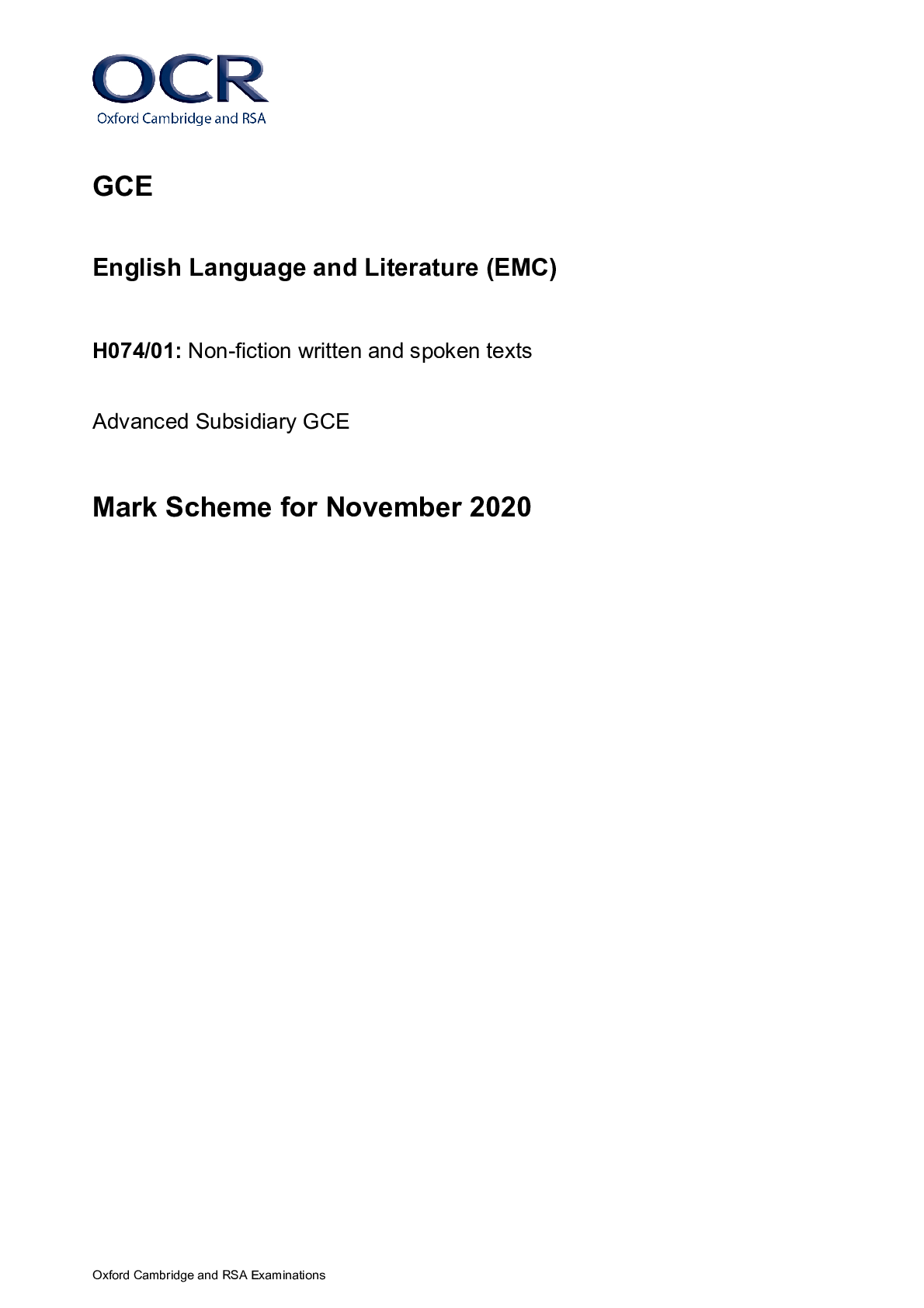
Reviews( 0 )
Document information
Connected school, study & course
About the document
Uploaded On
Oct 10, 2022
Number of pages
22
Written in
Additional information
This document has been written for:
Uploaded
Oct 10, 2022
Downloads
0
Views
45








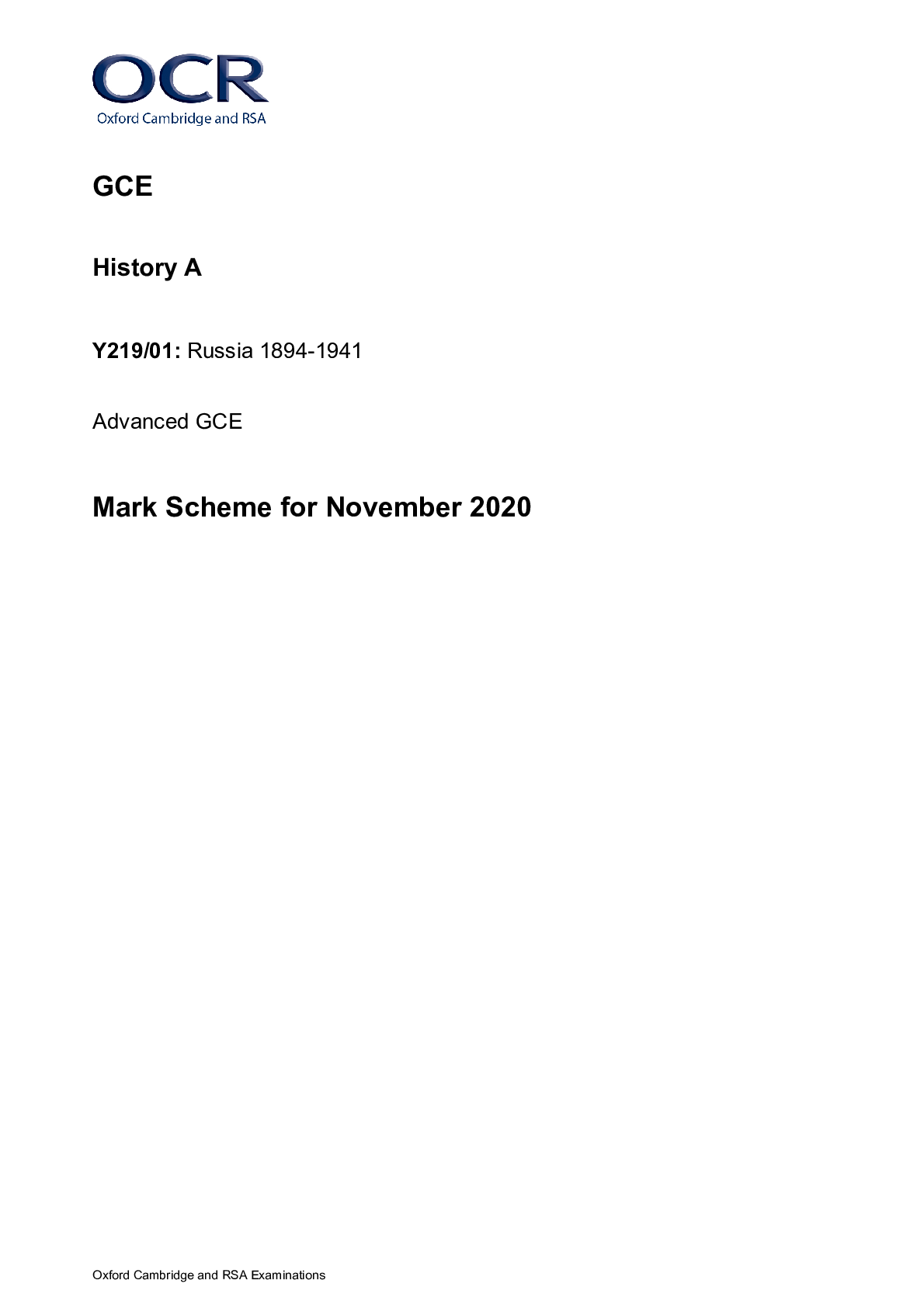
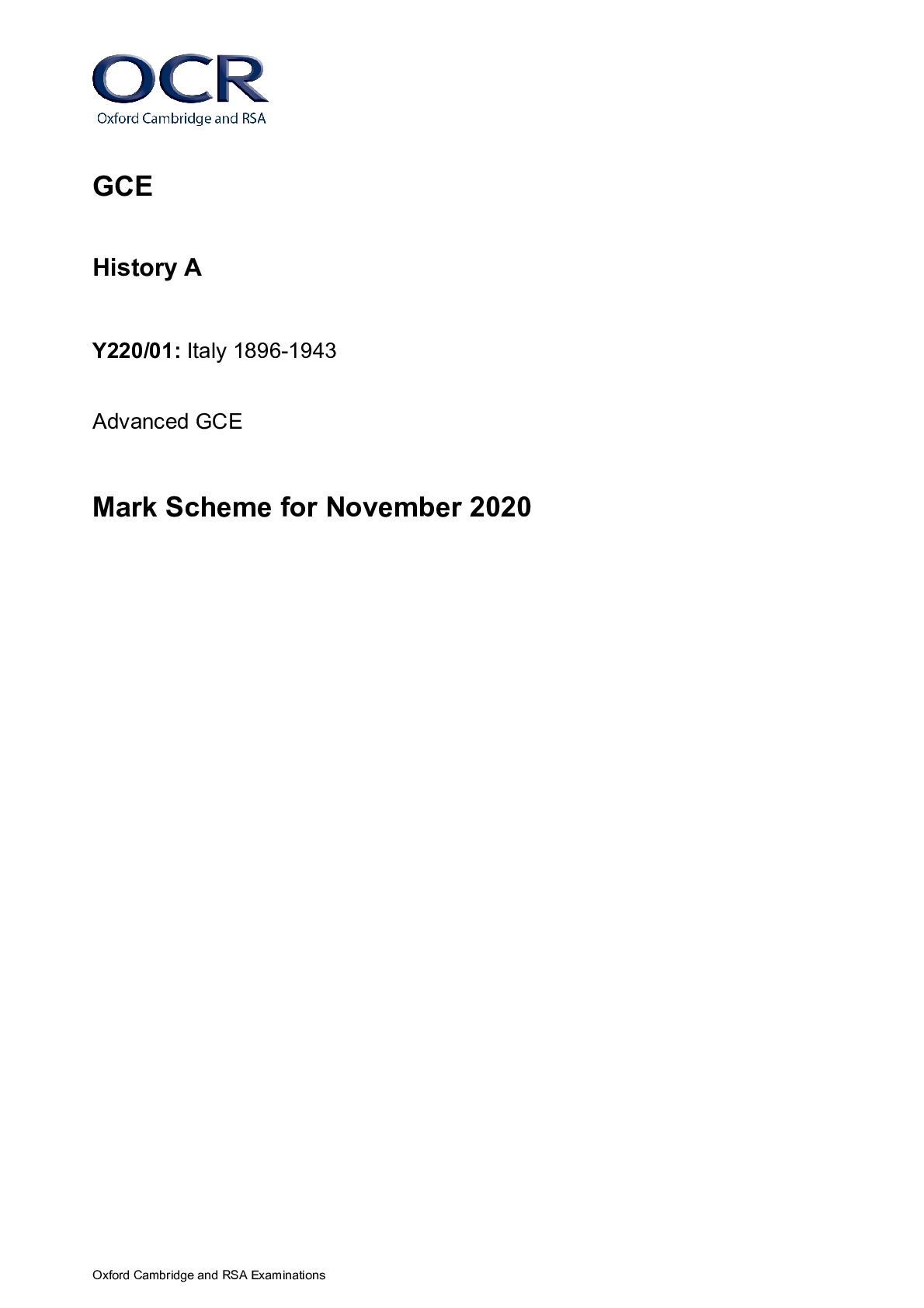

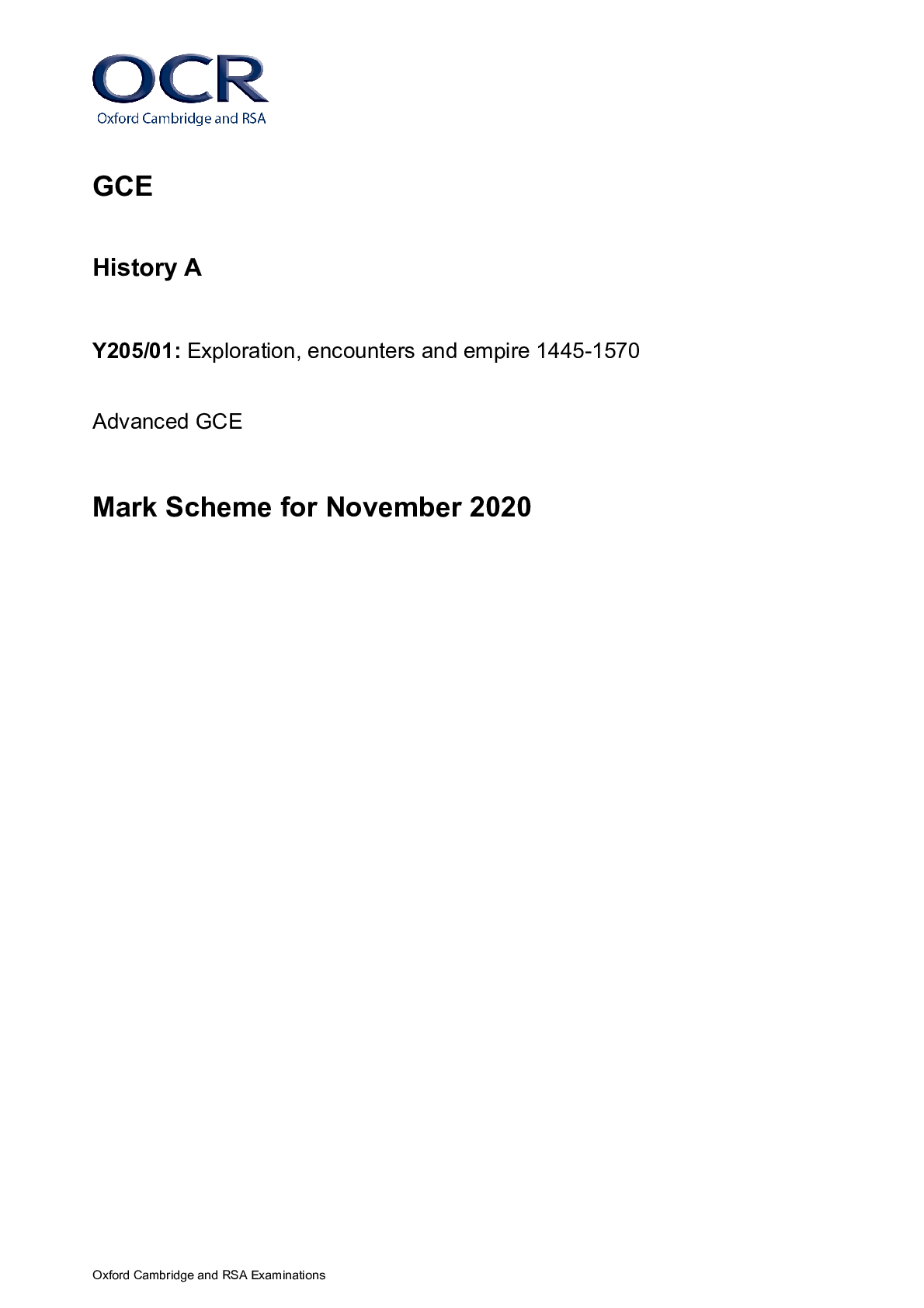
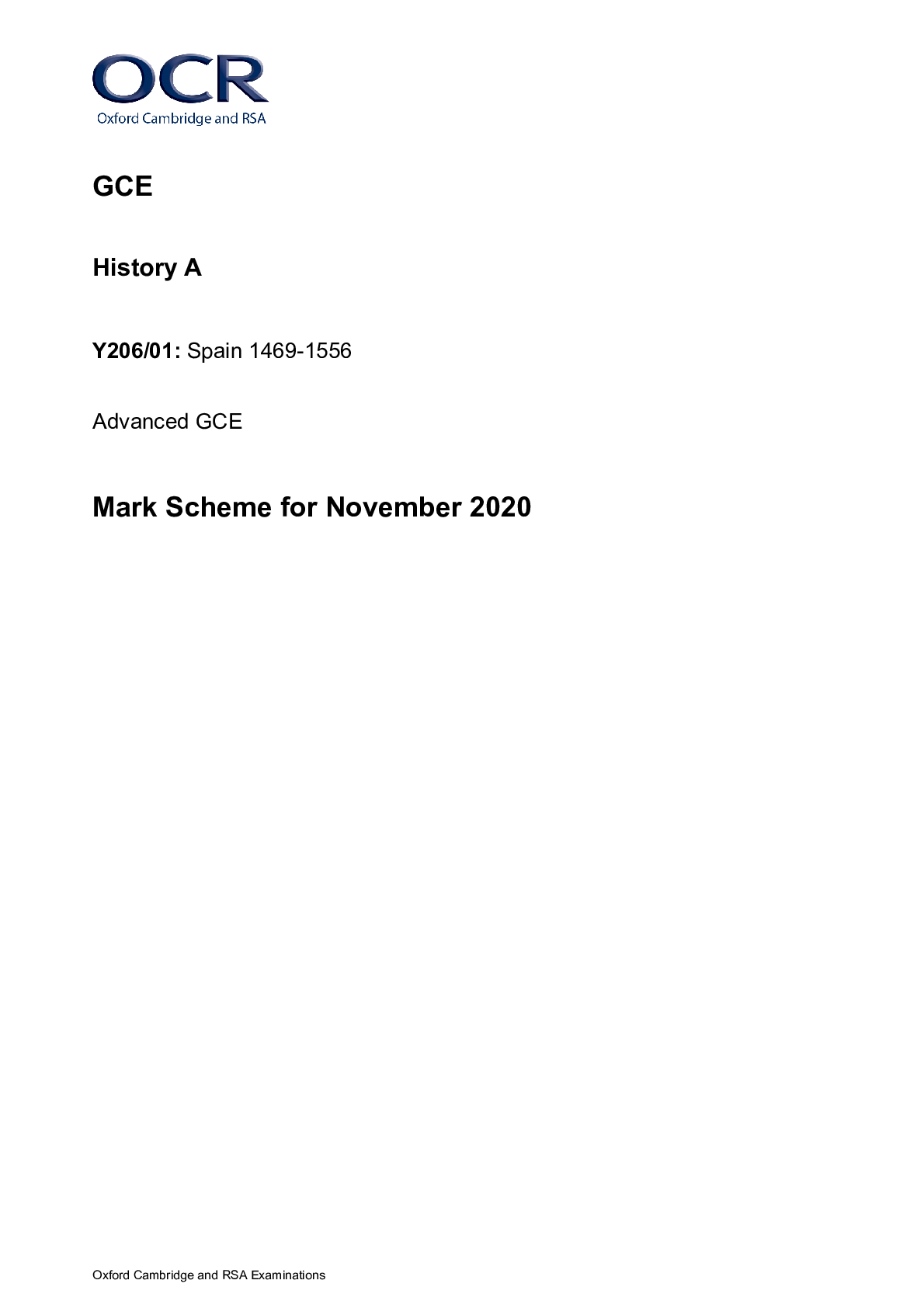
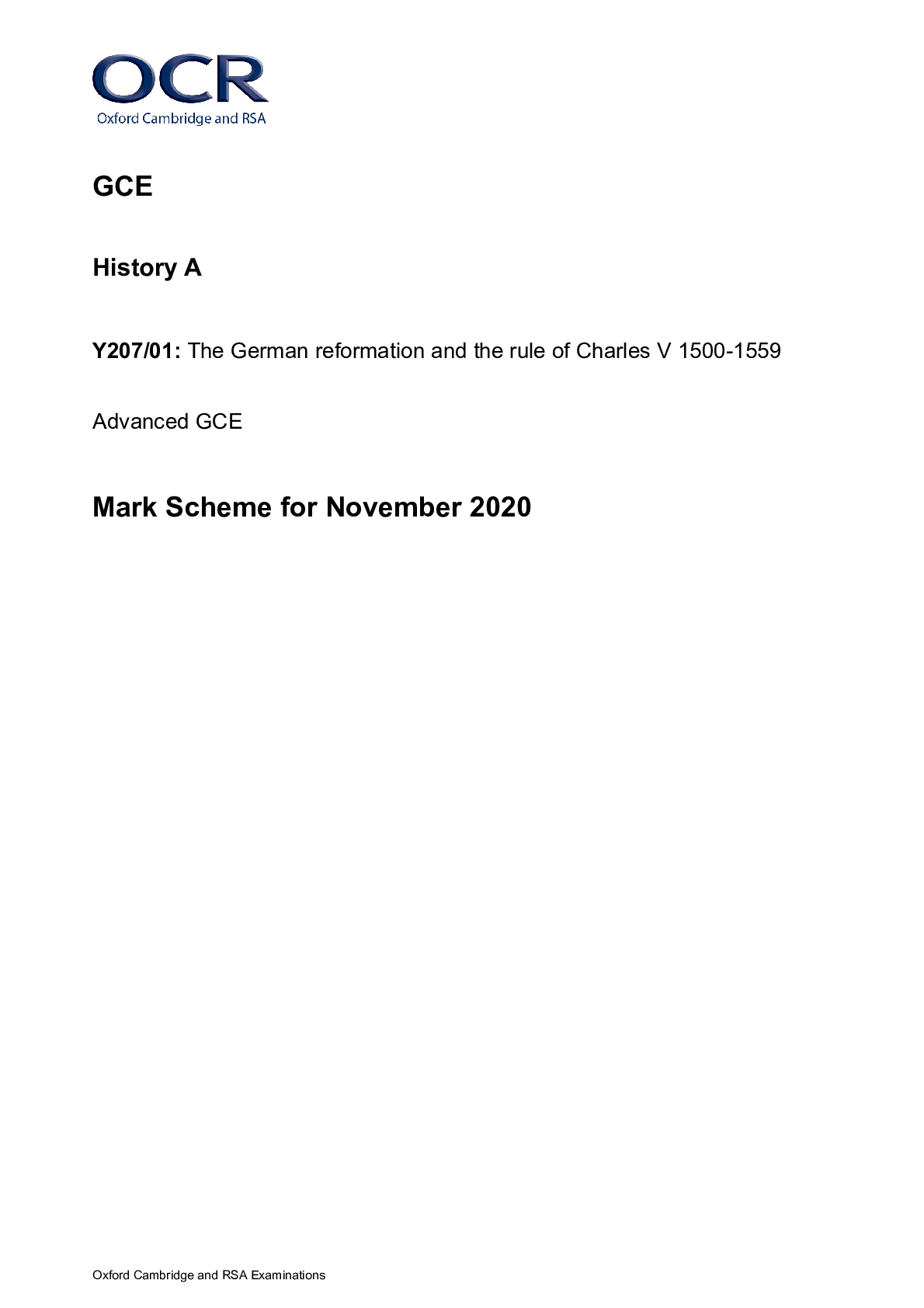
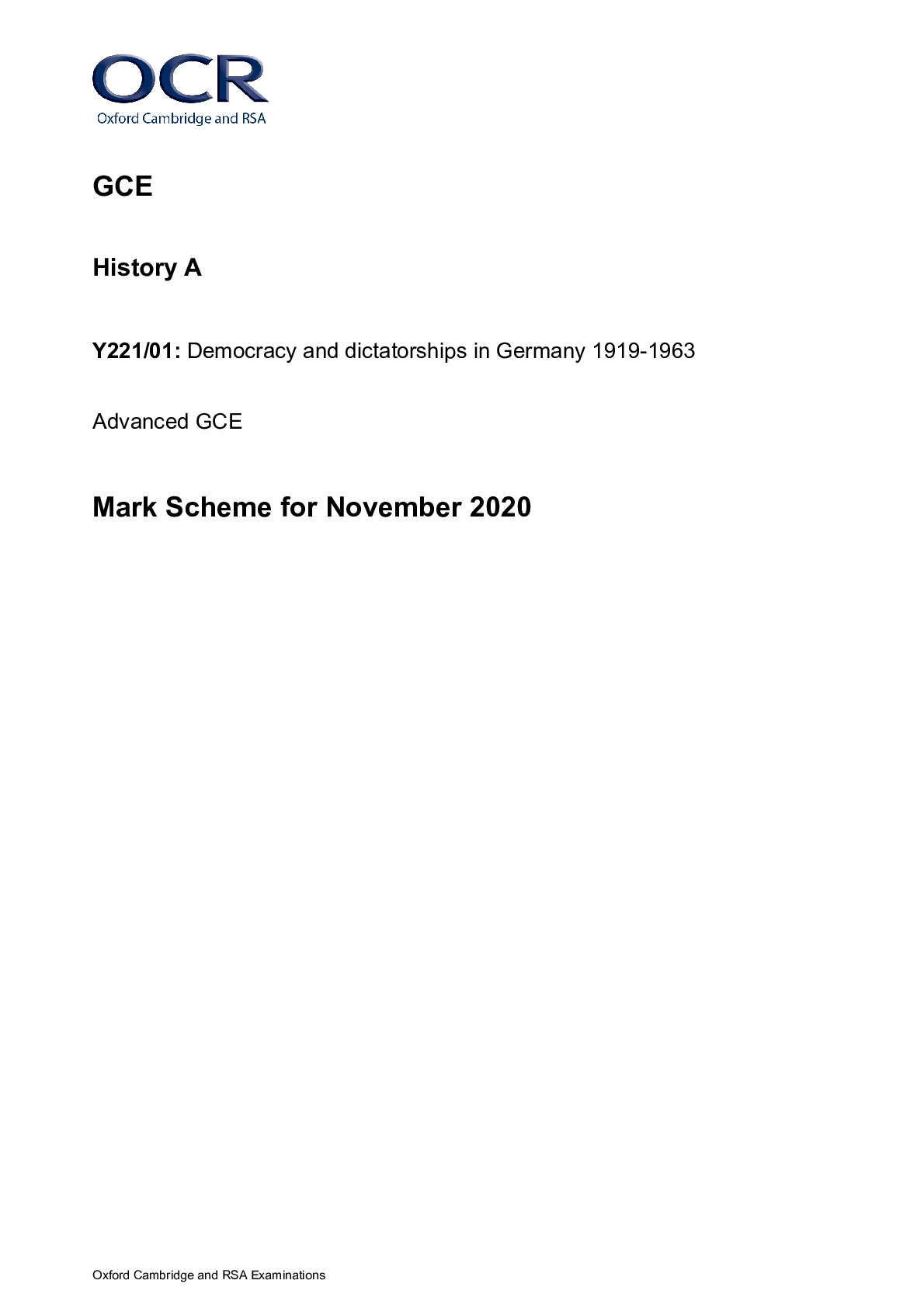

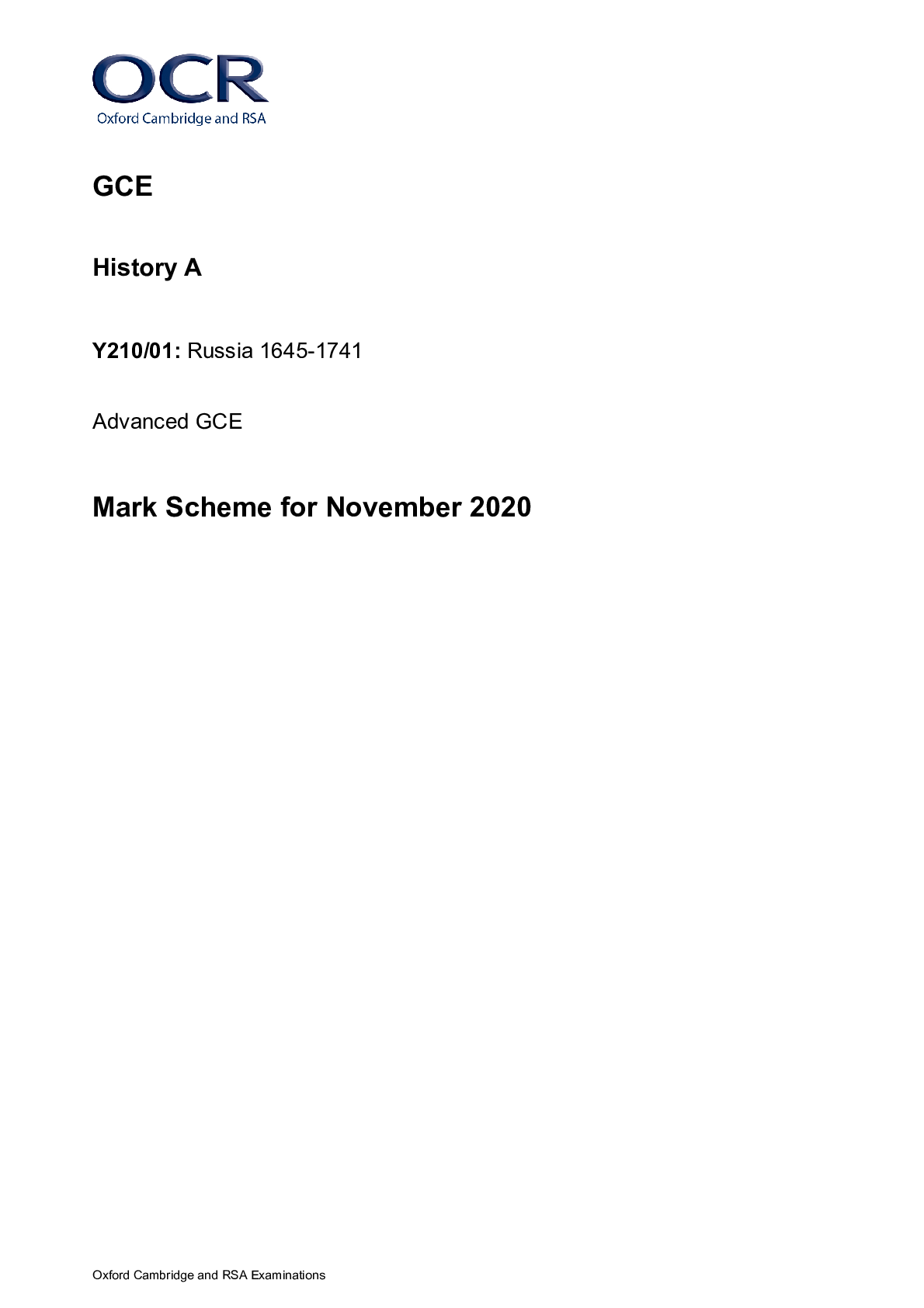


.png)






